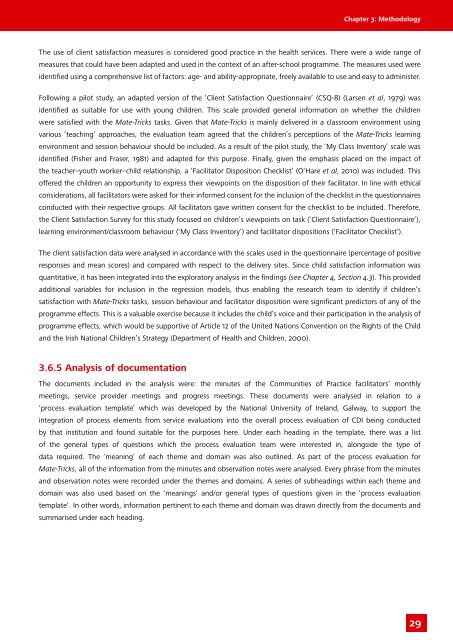Download Full Report (PDF, 1.36MB) - Queen's University Belfast
Download Full Report (PDF, 1.36MB) - Queen's University Belfast
Download Full Report (PDF, 1.36MB) - Queen's University Belfast
Create successful ePaper yourself
Turn your PDF publications into a flip-book with our unique Google optimized e-Paper software.
The use of client satisfaction measures is considered good practice in the health services. There were a wide range of<br />
measures that could have been adapted and used in the context of an after-school programme. The measures used were<br />
identified using a comprehensive list of factors: age- and ability-appropriate, freely available to use and easy to administer.<br />
Following a pilot study, an adapted version of the ‘Client Satisfaction Questionnaire’ (CSQ-8) (Larsen et al, 1979) was<br />
identified as suitable for use with young children. This scale provided general information on whether the children<br />
were satisfied with the Mate-Tricks tasks. Given that Mate-Tricks is mainly delivered in a classroom environment using<br />
various ‘teaching’ approaches, the evaluation team agreed that the children’s perceptions of the Mate-Tricks learning<br />
environment and session behaviour should be included. As a result of the pilot study, the ‘My Class Inventory’ scale was<br />
identified (Fisher and Fraser, 1981) and adapted for this purpose. Finally, given the emphasis placed on the impact of<br />
the teacher–youth worker–child relationship, a ‘Facilitator Disposition Checklist’ (O’Hare et al, 2010) was included. This<br />
offered the children an opportunity to express their viewpoints on the disposition of their facilitator. In line with ethical<br />
considerations, all facilitators were asked for their informed consent for the inclusion of the checklist in the questionnaires<br />
conducted with their respective groups. All facilitators gave written consent for the checklist to be included. Therefore,<br />
the Client Satisfaction Survey for this study focused on children’s viewpoints on task (‘Client Satisfaction Questionnaire’),<br />
learning environment/classroom behaviour (‘My Class Inventory’) and facilitator dispositions (‘Facilitator Checklist’).<br />
The client satisfaction data were analysed in accordance with the scales used in the questionnaire (percentage of positive<br />
responses and mean scores) and compared with respect to the delivery sites. Since child satisfaction information was<br />
quantitative, it has been integrated into the exploratory analysis in the findings (see Chapter 4, Section 4.3). This provided<br />
additional variables for inclusion in the regression models, thus enabling the research team to identify if children’s<br />
satisfaction with Mate-Tricks tasks, session behaviour and facilitator disposition were significant predictors of any of the<br />
programme effects. This is a valuable exercise because it includes the child’s voice and their participation in the analysis of<br />
programme effects, which would be supportive of Article 12 of the United Nations Convention on the Rights of the Child<br />
and the Irish National Children’s Strategy (Department of Health and Children, 2000).<br />
3.6.5 Analysis of documentation<br />
Chapter 3: Methodology<br />
The documents included in the analysis were: the minutes of the Communities of Practice facilitators’ monthly<br />
meetings, service provider meetings and progress meetings. These documents were analysed in relation to a<br />
‘process evaluation template’ which was developed by the National <strong>University</strong> of Ireland, Galway, to support the<br />
integration of process elements from service evaluations into the overall process evaluation of CDI being conducted<br />
by that institution and found suitable for the purposes here. Under each heading in the template, there was a list<br />
of the general types of questions which the process evaluation team were interested in, alongside the type of<br />
data required. The ‘meaning’ of each theme and domain was also outlined. As part of the process evaluation for<br />
Mate-Tricks, all of the information from the minutes and observation notes were analysed. Every phrase from the minutes<br />
and observation notes were recorded under the themes and domains. A series of subheadings within each theme and<br />
domain was also used based on the ‘meanings’ and/or general types of questions given in the ‘process evaluation<br />
template’. In other words, information pertinent to each theme and domain was drawn directly from the documents and<br />
summarised under each heading.<br />
29

















